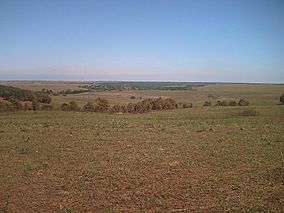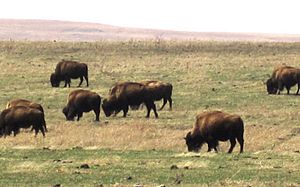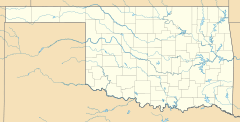Tallgrass Prairie Preserve facts for kids
Quick facts for kids Joseph H. Williams Tallgrass Prairie Preserve |
|
|---|---|

Tallgrass Prairie Preserve
|
|
| Location | Osage County, Oklahoma |
| Nearest city | Pawhuska |
| Area | 45,000 acres (180 km2) |
| Established | 1989 |
| Governing body | The Nature Conservancy |
The Joseph H. Williams Tallgrass Prairie Preserve is a special place in Osage County, Oklahoma. It's near the town of Foraker, Oklahoma. This preserve protects the largest area of tallgrass prairie left anywhere in the world.
The Nature Conservancy manages this huge preserve. They own about 39,000 acres (160 km2) of land. They also lease another 6,000 acres (24 km2). This area is part of the original tallgrass region. This vast grassland once stretched from Texas all the way to Manitoba in Canada.
Contents
What is the Tallgrass Prairie Preserve?
The preserve is located at the southern end of the Flint Hills. These hills are also known as the Osage Hills. This rocky, rolling grassland stretches from northern Kansas into Oklahoma.
It's hard to grow crops here because of the exposed limestone rocks. This is why the Flint Hills have stayed mostly natural. Long ago, they were hunting grounds for Native American tribes. These included the Wichita, Osage, and Kaw tribes. People in Oklahoma often call this area "The Osage." This name comes from the Native American tribe and the county named after them.
Land and Plants

Salt Creek and its smaller streams flow through the preserve. These areas have many trees. The eastern part of the preserve is in the Cross Timbers. This is a long belt of thick oak forests. These forests made it hard for early travelers to go west.
About 10 percent of the preserve is forest. The rest is tallgrass prairie. The grasses here can grow very tall, up to 10 feet (3 m) high!
The Importance of Fire
Tallgrass prairies need fire to survive. Fires can be caused by lightning or by people. Without fire, the prairie would quickly turn into a brushy area. Native Americans knew this. They regularly burned the prairie. This helped new, fresh grasses grow. It also stopped unwanted trees and bushes from taking over.
The Nature Conservancy continues this practice today. They use a method called "patch burning." They burn about one-third of the prairie each year. This helps the land in many ways. It provides good grazing for bison and cattle. It also creates a good home for the threatened greater prairie chicken. These birds live in small numbers on the preserve.
Animals of the Preserve
Bison are a main attraction at the preserve. Each fall, the bison are rounded up. Any extra bison are sold. Cattle also graze on about 11,000 acres (45 km2) of the land.
The preserve is home to 755 different plant species. Many of these plants are special to the tallgrass prairie. More than 300 types of birds live here too. The forests have many kinds of trees. These include oak, cottonwood, ash, red cedar, elm, and sycamore.
The preserve also has many interesting insects. The prairie mole cricket (Gryllotalpa major) is a rare insect found here. In spring, male crickets gather to make loud calls. They do this from their burrows to attract flying females. In summer, the preserve is home to the endangered American burying beetle (Nicrophorus americanus). This beetle helps recycle nutrients in the soil.
History of the Land
The Tallgrass Prairie Preserve is on land that was once the Osage Indian Reservation. When the Osage people had to divide their shared land into family plots, they kept the rights to minerals under the ground. This included oil.
In the early 1900s, oil was found on their land. This made the Osage people very wealthy. They faced many challenges because of this wealth. Today, there are still over 100 oil wells on the preserve. The bison often graze right among them.
History of the Preserve
Before The Nature Conservancy bought the land in 1989, much of it was part of the Barnard Ranch. This ranch was once a huge 100,000 acres (400 km2) property called the Chapman-Barnard ranch.
In 1993, an Oklahoma oilman named Kenneth Adams donated 300 bison to the preserve. By the year 2000, the bison herd had grown to 1,200. Now, the herd has more than 2,500 bison. They graze on 21,000 acres (85 km2) of mostly open land.
Visiting the Preserve
Pawhuska, Oklahoma, is the closest large town. The Osage Nation has its main offices there. You can also enter the preserve near Foraker, Oklahoma, and Hewins, Kansas. The Tallgrass Prairie Preserve is open every day from dawn until dusk. There is no charge to enter.
The old headquarters of the Chapman-Barnard ranch is now a visitor center. It has restrooms and a gift shop. You can also see the restored bunkhouse where cowboys used to live. The main building is listed on the National Register of Historic Places. The gift shop is open from 10 a.m. to 4 p.m. from March to mid-November. Oklahoma State University has a research station at the visitor center.
Trails and Wildlife Viewing
Near Salt Creek, there are two hiking trails. One is a short nature trail. The other is a 2-mile (3 km) trail. It climbs to viewpoints over the creek and through the forest. You can often see bison just across the fence from the hiking area. White-tailed deer are also common in the wooded parts.
Most of the 10,000 visitors each year enjoy driving the dirt roads. They come to see the many bison. Often, hundreds of bison can be seen near the roads, sometimes even blocking them! Scenic spots along the roads offer wide views of the rolling prairie. It looks bright green in spring, tall and brown in fall, and covered with wildflowers in summer.
A famous Osage writer, John Joseph Mathews, had a small cabin in the Osage Hills. He did much of his writing there. He asked to be buried near his cabin. Around 2014, The Nature Conservancy bought this area. They added it to the Tallgrass Prairie Preserve. The cabin will be kept safe, and people will be able to visit it sometimes.
Images for kids
-
In March bison graze the new green grass in areas of the preserve that were burned the previous fall.







